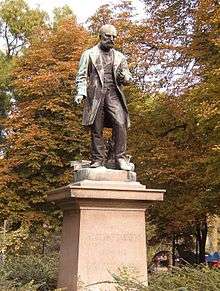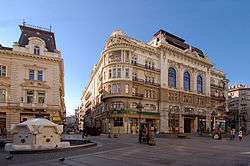Josif Pančić
Josif Pančić (Serbian Cyrillic: Јосиф Панчић; April 17, 1814 – February 25, 1888) was a Serbian botanist, Doctor of Medicine, a lecturer at the Great School, the future University of Belgrade, and the first president of the Serbian Royal Academy. He extensively documented the flora of Serbia, and is credited with having classified many species of plants which were unknown to the botanical community at that time.[1] Pančić is credited for discovering the Serbian Spruce. He is regarded as the father of Serbian botany.[2]
Јосиф Панчић | |
|---|---|
Josif Pančić | |
| Born | April 17, 1814 Ugrini, Austrian Empire (now Croatia) |
| Died | February 25, 1888 (aged 73) Belgrade, Kingdom of Serbia (now Serbia) |
| Citizenship | Serbian |
| Alma mater | University of Budapest |
| Known for | discovery of Serbian Spruce |
| Scientific career | |
| Author abbrev. (botany) | Pančić |
Life
Early life and studies
Pančić was born in Ugrini, near Crikvenica, at the time part of the Austrian Empire (now Croatia), the fourth son of Pavel Pančić and Margarita. The Pančić family was of Serb and Bunjevac origin.[3][4]He was Born as Croat in a distinctly Croatian region.[5] According to tradition, the Pančić family hailed from Herzegovina and settled in Ugrini in olden times.[6] After finishing elementary school in Gospić, he went on to the lyceum in Rijeka, and then continued classes in the Regia Academica Scientiarum in Zagreb (1830). He graduated in 1842 in Budapest in medicine. In addition to other courses, Pančić attended botany courses, taught by the then renowned botany professor, Joseph Sadler (Sadler József).[7] Later, recalling those early lectures, he wrote:[2]
“And since the first course in botany I started to love botany and decided to become a botanist..."
Work

He was acquainted with the Serbian linguist Vuk Stefanović Karadžić in Vienna who wrote him a letter of recommendation to the Serbian authorities in order to fulfill his wish to settle in the Principality of Serbia and to study its nature.[8] In May 1846 he arrived in Serbia and worked as a physician in rural Serbia. In 1853, he moved from Kragujevac to Belgrade when he was appointed as one of six professors (Konstantin Branković, Jovan Sterija Popović, Đura Daničić, Matija Ban, and Dimitrije Nešić) at the Belgrade Lyceum of the Principality of Serbia. In 1853, he introduced Mineralogy with geology at the Lyceum.[9]

He extensively documented the flora of Serbia and is credited with having classified many species of plants that were unknown to the botanical community at that time. Pančić discovered a total of 47 valid species new to science.[10] The crowning achievement of Pančić floristic studies is the Flora of the Principality of Serbia (Flora Kneževine Srbije) published in 1874, while its Supplement appeared ten years later. His explorations marked the golden age of Serbia's botany.[10]
His most significant discovery was the Serbian Spruce,[11] which he had discovered near Zaovine on the Tara Mountain in 1875. He firmly established Serbian botany among European sciences. He ascertained that Serbia's flora was rich, and worthy of further studies.[10] During the Serbian–Ottoman War (1876–78), he was the Chief Physician of the Belgrade Hospital.
He is said to have "fallen in love" with Kopaonik, which he visited 16 times between 1851 and 1886.[12] Pančić was named the first president of the Serbian Royal Academy formed on April 5, 1887. He requested the opening of the Botanical garden "Jevremovac" in Belgrade.[13]
Pančić died on February 25, 1888, in Belgrade while at work. A mausoleum of Josif Pančić was erected on Kopaonik in 1951 by the Academy, the University of Belgrade and the Hikers union[14], with the inscription:
Honoring Pančić's request, we moved him here to rest forever. We also announce his message for the Serbian youth: "Only with a thorough understanding and analysis of the nature of our country will they show how much they love and honor their homeland".
Legacy

A research society has been named after him, Josif Pančić Biological Research Society (Biološko istraživačko društvo "Josif Pančić"). He was depicted on the 10 Dinars note printed in 1994. He is included in The 100 most prominent Serbs. In 1951 the highest point in the Kopaonik mountain range was changed from Milan Peak to Pančić's Peak.[15]
On April 17, 2010, Google celebrated his birthday with a Google Doodle.[16]
Selected works
- Die Flora der Serpentinberge in Mittel-Serbien (1859)
- Pisces Serbiae (1860)
- Zur Moosflora des nordöstlichen Banates (1861)
- Arena mobilis in Serbia eiusque flora (1863)
- Flora agri Belgradensis methodo analytica digesta – "Flora u okolini Beogradskoj po analitičnom metodu" (1865)
- Šumsko drveće i šiblje u Srbiji (1871)
- Flora Principatus Serbiae – "Flora knez̆evine Srbije ili vaskularne biljke, koje y Srbije divlie rastu" (1874)
- Eine neue conifere in den östlichen Alpen (1876)
- Flora u okolini Beogradskoj po analitičnoj sistemi (1878)
- Elementa ad floram principatus, Bulgariae (1883)
- Nova graca za flora knez︠h︡evine Bugarske (1886)
- Collected works in 11 volumes[17]
Notes
- His name is mostly written as Serbian Josif Pančić (Јосиф Панчић), and also rendered Croatian Josip Pančić (Јосип Панчић).
References
- Lubarda, Biljana. "Plant species and subspecies discovered by Dr. Josif Pančić 1 – distribution and floristic importance". Cite journal requires
|journal=(help) - Vasić, Olja. "Josif Pančić and the new Fora of Serbia" (PDF). Flora Mediterranea. 23: 209–214. ISSN 2240-4538. Archived from the original (PDF) on 4 August 2016. Retrieved 20 October 2015.
- Jovan Erdeljanović (1930). O poreklu Bunjevaca. Srpska Kraljevska Akademija. p. 146.
Панчићи, Паншни у Суботици, од 1686 год. (Оашса 1891 24; види и 5гађ. II Окт. 37, Иеуеп 1896 83, 123); кат. Панчићи у Хрватском Приморју (М. Милићевић: Поменик зна- менитих људи, Београд 1888, с. 497; Јегеппс 161) и прав. у ...
- Poreklo.rs, Буњевачка презимена: Обрадов(ић) – Паштровић "ПАНЧИЋИ / ПАНЧИНИ – у Суботици, од 1686.год.; католици Панчићи у Хрватском Приморју и православни у Славонији."
- Ivan Barbarić; (2014) Uz 200. obljetnicu rođenja dr. Josipa Pančića (1814.–1888.) (On the occasion of the 200th anniversary of the birth of Dr. Josip Pančić (1814–1888) p. 100,
- Josif Pančić, Budislav Tatič, Božidar P. M. Ćurčić (1998). Sabrana dela Josifa Pančića: Život i delo Josifa Pančića. Zavod za udžbenike i nastavna sredstva. p. 13.
Проф. др Љубиша М. Глишић ЖИВОТ И РАД ВЕЛИКОГ НАУЧНИКА И РОДОЉУБА др ЈОСИФА ПАНЧИЋА Према предању, Панчићи су пореклом из Херцеговине и од давнина су се доселили у село Угрине, које се налази на ...
CS1 maint: multiple names: authors list (link) - Stevanovic et al. 1999.
- "Josif Pančić". srednjeskole.edukacija.rs. Retrieved 2019-12-12.
- Miomir Komatina (31 March 2004). Medical Geology: Effects of Geological Environments on Human Health. Elsevier. pp. 359–. ISBN 978-0-08-053609-5.
- Ioannes Tsekos; Michael Moustakas (6 December 2012). Progress in Botanical Research: Proceedings of the 1st Balkan Botanical Congress. Springer Science. p. 142. ISBN 978-94-011-5274-7.
- Ballian, Dalibor (2018). "NEW FINDINGS OF SERBIAN SPRUCE (Picea omorika (Panč.) Purk.) IN BOSNIA AND HERCEGOVINA". Cite journal requires
|journal=(help) - "Josif Pancic i Kopaonik". staro.skijanje.rs. Retrieved 2019-12-12.
- "KAKO JE PODIGNUT JEVREMOVAC – Nauka kroz priče". Retrieved 2019-12-12.
- "Mauzolej Josifa Pančića propada". www.novosti.rs (in Serbian). Retrieved 2019-12-12.
- "Josif Pancic i Kopaonik". 2011-01-03. Archived from the original on 2011-01-03. Retrieved 2019-12-28.
- "Josif Pancic's Birthday". Google. 17 April 2010.
- "SABRANA DELA JOSIFA PANČIĆA". www.knjizara.zavod.co.rs. Retrieved 2019-12-12.
- IPNI. Pančić.
Sources
- Nikola Diklić. "Josif Pančić" (PDF). Lives and work of the Serbian scientists. 1: 3–61. Archived from the original (PDF) on 2015-06-21. Retrieved 2016-01-08.
External links
| Wikimedia Commons has media related to Josif Pančić. |
- "Archived copy" Јосиф Панчић (in Serbian). Serbian Academy of Sciences and Arts. Archived from the original on 2011-10-09. Retrieved 2009-03-11.CS1 maint: archived copy as title (link)
- Vladimir Stevanovic, Radomir Konjevic, Slobodan Jovanovic, Dmitar Lakušic, Snežana Vukojičic, Marjan Niketic (1999). "Life road of Josif Pancic". Retrieved 2007-07-12.CS1 maint: uses authors parameter (link)
- Feljton: Josif Pančić, Večernje Novosti, 27 February 2008 – 2 March 2008 (in Serbian)
| Academic offices | ||
|---|---|---|
| Preceded by Post established |
President of Serbian Academy of Sciences and Arts 1887–1888 |
Succeeded by Čedomilj Mijatović |
